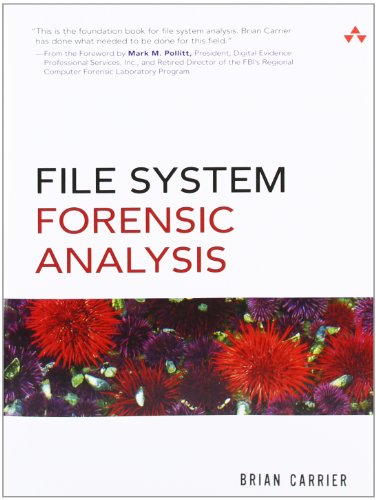File System Forensic Analysis download
Par bearden doretha le dimanche, avril 16 2017, 21:42 - Lien permanent
File System Forensic Analysis by Brian Carrier


Download eBook
File System Forensic Analysis Brian Carrier ebook
Format: chm
Publisher: Addison-Wesley Professional
Page: 600
ISBN: 0321268172, 9780321268174
Infinite Skills Learning Computer Forensics English | Mp4 | h264 | 1280x720 | 25.00 fps | Mp3 128kbps 48000hz | 1.75Gb Genre: Video Tutorials This video based Computer Forensics training. 0405 Boot Processes 0406 File Systems: Windows-Based 0407 File Systems: Linux 0408 File Systems: Mac OS 0409 File Systems: CD 0410 RAID 0411 Autostarting 0412 Executable Types And Structure: Windows 0413 Executable Types And Structure: Unix-Based 0414 Disk Partitions 05. Using hashdeep, I compared the hashes from the tainted virtual machine against the hashes from the clean virtual machine: 68 files had a hash that did not match any of the hashes in the clean set. I'm writing this article for two main reasons. Tuesday, 5 March 2013 at 13:48. The most interesting files are: ~/.local/share/ gvfs-metadata/home: I don't think the TBB can really do anything to make a system forensics proof against somebody who has physical possession of the machine. At the time of choosing what to do, I was enrolled in another class focusing on file system forensics and we were doing in depth analysis of the FAT file system. First, I've got an anti-forensics class to teach, so I have to learn it anyway. Get today's news and top headlines for forensics professionals - Sign up now! Forensically interesting spots in the Windows 7, Vista and XP file system and registry. Windows Restore Points themselves can be of forensic importance because they represent snapshots of a computer's Registry and system files. Nazarijo writes “The field of investigative forensics has seen a huge surge in interest lately, with many looking to study it because of shows like CSI or the increasing coverage of computer-related crimes. Digital Evidence and Computer Crime, Third Edition provides the knowledge necessary to uncover and use digital evidence effectively in any kind of investigation. Most digital evidence is stored within the computer's file system, but understanding how file systems work is one of the most technically challenging concepts for a digital investigator because there exists little documentation. Most digital forensics evidence is stored within the computer's file system, but working with file systems is the most technically challenging aspect of forensic analysis. Once in a while, a colleague, neighbor or friend will call me in a panic over files they have accidentally deleted from the SSD card in their daughter's camera or worse. With modules for file system analysis, e-mail, keyword search, registry, and bookmarking, Forensic Explorer has the essentials.